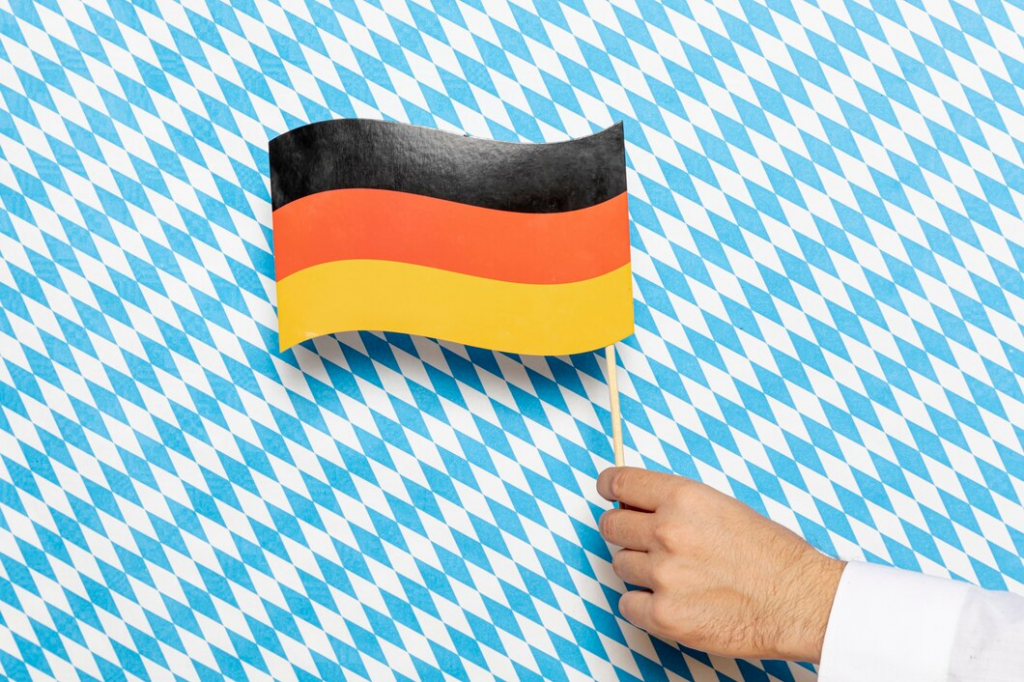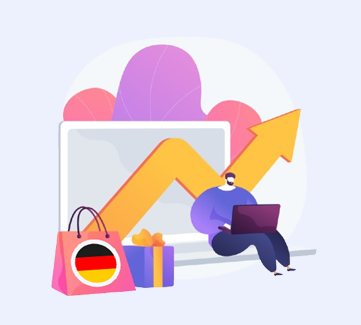
Germany stands as the largest ecommerce market in Europe and ranks as the third-largest worldwide, making it an enticing destination for businesses aiming to expand internationally. However, entering the German market presents significant challenges. Achieving success necessitates a thorough understanding of local consumer behavior, legal regulations, logistics, and competitive dynamics. Careful planning, including meticulous market research and legal compliance, is crucial to ensure a successful German market entry. This guide provides essential insights to help you successfully establish your ecommerce business in Germany whether you are selling toys online on your own website or selling supplements on marketplaces .
Overview of the German Ecommerce Market
Market Size, Trends, and Market Research
Germany’s ecommerce market is valued at over €100 billion and continues to experience robust growth. With a tech-savvy population and strong online purchasing habits, German consumers frequently shop online for a wide range of products, including electronics, fashion, household goods, and groceries.
Germany’s significant national output, driven by over 40% exports, plays a crucial role in fueling the ecommerce market, highlighting the country’s economic strength and its key industries.
Key trends 2025 in the market include:
- The increasing dominance of marketplaces (Amazon.de, Otto, eBay.de, Zalando)
- High demand for sustainable and eco-friendly products
- Growing interest in cross-border ecommerce
- Preference for secure and trusted payment methods
Consumer Behavior in Germany
Understanding the mindset of German shoppers is crucial:
- Trust is key: German consumers are cautious buyers who value transparency, high-quality products, and reliable service. Reviews, certifications, and guarantees can significantly impact sales.
- Price sensitivity: While Germans appreciate quality, they are also price-conscious. Competitive pricing and discounts are effective marketing tools.
- Preference for local retailers: Many Germans prefer buying from German or European sellers due to trust and familiarity. However, international brands can still succeed with the right strategy.
- Strong environmental awareness: Sustainable packaging, carbon-neutral shipping, and eco-friendly products can provide a competitive edge.
Before expanding into the German market, it is essential to evaluate the home market to ensure that local growth opportunities have been maximized.
Market Research and Analysis before German Market Entry
Market research and analysis are crucial steps in understanding the German market and developing a successful market entry strategy. This involves gathering and analyzing data on the target market, including demographics, consumer behavior, and market trends. It also involves analyzing the competitive landscape, including the strengths and weaknesses of existing competitors.
Conducting market research can be approached through various methods, such as surveys, focus groups, and online analytics. It’s essential to gather data from multiple sources to ensure accuracy and reliability. The data collected should be analyzed to identify patterns, trends, and insights that can inform your market entry strategy.
Some key factors to consider when conducting market research in Germany include:
- Demographics: Germany has a diverse population with varying age groups, income levels, and education levels. Understanding these demographics can help tailor your products and marketing efforts to specific segments.
- Consumer Behavior: German consumers tend to be loyal to their favorite brands and are willing to pay a premium for high-quality products. They value transparency, reliability, and sustainability.
- Market Trends: The German market is highly competitive, with a strong focus on innovation and technology. Staying abreast of the latest trends can help you stay ahead of the competition.
By conducting thorough market research and analysis, businesses can gain a deeper understanding of the German market and develop a successful market entry strategy.
Economic Growth and Trade
Germany is the largest economy in the European Union and has a strong track record of economic growth. The country boasts a highly developed infrastructure, a skilled workforce, and a favorable business environment. Germany is also a significant player in international trade, with a strong focus on exports.
Some key economic indicators for Germany include:
- GDP Growth Rate: Germany has a stable GDP growth rate, with an average annual growth rate of 1.5% over the past decade. This steady growth reflects the country’s robust economic health.
- Unemployment Rate: Germany has a low unemployment rate, averaging around 3.5% annually over the past decade. This indicates a strong labor market and a high level of employment.
- Inflation Rate: Germany maintains a low inflation rate, with an average annual rate of 1.5% over the past decade. This stability in prices is beneficial for both consumers and businesses.
Germany’s strong economy and favorable business environment make it an attractive market for businesses looking to expand their operations. However, the country also faces significant challenges, including a rapidly aging population and a need for increased investment in infrastructure and education. Addressing these challenges will be crucial for sustaining long-term economic growth.
German Market Entry Strategies

There are several market entry strategies that businesses can use to enter the German market. Some of the most common strategies include:
- Exporting: Selling products or services directly to customers in Germany. This is often the simplest and least risky method, but it may involve higher shipping costs, getting essential EORI number and longer delivery times.
- Licensing: Granting a license to a local business to manufacture and sell products or services in Germany. This can be a cost-effective way to enter the market, but it requires finding a reliable local partner.
- Franchising: Granting a franchise to a local business to operate a business in Germany. This allows for rapid expansion with lower capital investment, but it requires strong brand control and support systems.
- Joint Venture: Partnering with a local business to establish a joint venture in Germany. This can provide valuable local expertise and resources, but it involves sharing profits and decision-making.
- Wholly-Owned Subsidiary: Establishing a wholly-owned subsidiary in Germany. This offers complete control over operations and profits, but it requires significant investment and carries higher risk.
Each market entry strategy has its advantages and disadvantages, and the choice of strategy will depend on the specific needs and goals of the business.
Choosing the Right Market Entry Strategy
Choosing the right market entry strategy for the German market requires careful consideration of several factors, including the business’s goals, resources, and risk tolerance. Some key factors to consider include:
- Market Size and Growth Potential: Germany is a large and growing market with a strong demand for high-quality products and services. Assessing the market size and growth potential can help determine the best entry strategy.
- Competition: The German market is highly competitive, with many established businesses competing for market share. Understanding the competitive landscape can help identify opportunities and threats.
- Cultural Differences: Germany has a unique culture and business environment, with a strong emphasis on quality, reliability, and customer service. Adapting to these cultural differences is crucial for success.
- Legal and Regulatory Requirements: Germany has a complex legal and regulatory environment, with many requirements that must be met to operate a business in the country. Ensuring compliance with these regulations is essential to avoid legal issues.
By carefully considering these factors, businesses can choose the right market entry strategy for the German market and achieve success in this competitive and rewarding market.
Legal Considerations and Market Entry Strategies for Selling in Germany

Germany has one of the strictest regulatory environments in Europe. Understanding compliance requirements is crucial for avoiding fines and legal issues.
Legal Structure & Registration
- Company Registration: Foreign sellers can operate via a German subsidiary (GmbH), a European entity, or organize distribution management cross-border without local registration.
- VAT (Umsatzsteuer): Any business selling to German consumers must comply with VAT regulations. If your annual sales exceed €10,000, you must register for VAT in Germany. The standard VAT rate is 19%, with a reduced 7% rate for certain products.
Compliance and Consumer Protection
- General Data Protection Regulation (GDPR): Any business operating in Germany must comply with GDPR regarding data collection, storage, and processing.
- Packaging Law (VerpackG): If you sell physical products, you must register with the Central Packaging Register (LUCID) and participate in a recycling scheme.
- Impressum Requirement: German websites must include an “Impressum,” which is a legal disclosure with business details, contact information, and responsible parties.
- Consumer Rights & Return Policy: German customers have strong rights, including a mandatory 14-day return policy for online purchases.
Selling on Marketplaces vs. Own Website
Most online shoppers in Germany prefer to buy from marketplaces rather than independent online stores. Here’s a breakdown of the most popular platforms:
- Amazon.de: The dominant player with over 50% market share. Requires compliance with Amazon’s VAT and regulatory policies.
- Otto.de: A well-known German marketplace focusing on fashion, furniture, and household goods.
- eBay.de: Popular for both new and second-hand goods.
- Zalando: The largest fashion marketplace in Germany.
If you opt for an independent online store, you’ll need a localized website, strong SEO, and effective digital marketing to compete with established players.
Logistics & Fulfillment in Germany

Fast and reliable shipping is a must in Germany. Consumers expect quick delivery times and hassle-free returns.
Warehousing & Fulfillment Options
- Local Warehousing: Setting up a local fulfillment center can speed up delivery and improve customer satisfaction in any type of warehouses. Many businesses use third-party logistics (3PL) providers such as DHL Fulfillment, WAPI, or Amazon FBA.
- Cross-Border Shipping: If you are shipping from another EU country, ensure competitive delivery times and costs. Long shipping times (over 3-5 days) can deter German buyers.
Preferred Delivery Methods
- DHL: The most trusted courier service in Germany, widely used for ecommerce.
- DPD & Hermes: Alternatives to DHL, offering competitive rates.
- Amazon FBA: Ideal for sellers using Amazon, as it ensures fast Prime delivery.
Returns Management
Germany has one of the highest return rates in Europe, especially in fashion and electronics. Offering free and easy returns is crucial for building trust with German customers.
Payment Preferences in Germany
Unlike in some other countries, credit cards are not the most popular payment method in Germany. Instead, Germans prefer:
- PayPal: The most widely used digital payment method.
- SEPA Direct Debit: Bank transfers are a trusted and common payment option.
- Klarna & Buy Now, Pay Later (BNPL): Many Germans prefer paying after receiving their products.
- Invoice Payments (Rechnungskauf): Particularly popular in B2B transactions and among older consumers.
Offering multiple payment methods is crucial to maximizing conversions.
Marketing & Customer Acquisition in Germany

Entering the German market requires a localized marketing approach.
SEO & Localization
- Your website should be in flawless German.
- Use .de domain for higher trust and better SEO ranking.
- Adapt product descriptions and marketing materials to German preferences and cultural nuances.
Performance Marketing
- Google Ads: Germans use Google extensively, making Google Shopping and search ads highly effective.
- Facebook & Instagram Ads: Great for targeting specific demographics, but ensure compliance with EU ad policies.
- Influencer Marketing: German consumers trust expert opinions. Partnering with local influencers can increase credibility.
Email & Retention Strategies
- Germans prefer detailed information, so well-structured newsletters with clear product benefits work well.
- Loyalty programs and personalized offers help retain customers.
Challenges and How to Overcome Them
Strict Regulations
Solution: Work with legal experts or compliance consultants to avoid fines and ensure smooth operations.
High Competition
Solution: Focus on differentiation, whether through pricing, branding, sustainability, or superior service.
Customer Trust Issues and Cultural Differences
Solution: Invest in customer reviews, certifications (e.g., Trusted Shops), and strong return policies to build credibility.
Logistics Complexity
Solution: Use 3PL services for efficient fulfillment and competitive shipping rates.
Final Thoughts: Is Germany, the Largest Economy in Europe, the Right Market for You?
Germany offers huge potential for ecommerce businesses, but it requires careful planning, regulatory compliance, and a strong marketing approach. Businesses must be prepared to navigate strict legal requirements, adapt to German consumer expectations, and compete with well-established local and international brands. Success in this market depends on offering high-quality products, providing excellent customer service, and ensuring efficient logistics with fast and reliable shipping. If you can meet these challenges and localize your strategy effectively, Germany can be a highly profitable and scalable market for long-term growth.



 Community
Community
